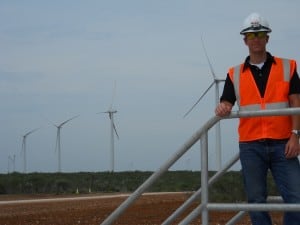NOTE: This article appeared in Utility Products magazine, which serves the utility industry — it is reprinted with permission. It details Medcor’s work onsite at wind farm construction projects. These large utility construction projects can involve hundreds of employees working over many miles for many months. The article provides general information about onsite health care, regardless of who the provider is, but also highlights some of Medcor’s specific value. Medcor has many years of experience serving the utility and construction industries and has developed specific protocols and systems for that on-site environment.
By Kate Woldhuis
During the American Wind Energy Association’s WINDPOWER 2011 Conference and Exhibition in May, Occupational Safety and Health Administration (OSHA) announced its National Emphasis Program would target safety inspections at wind farms. Because systematic inspections of safety compliance at wind farms nationwide are probably going to begin in 2012, it has become paramount for safety managers to build on existing safety knowledge and work within the workplace to promote the development of compliance requirements by the end of 2011. Many safety managers have brought in third-party contractors to support worksite health and safety goals, so they are free to focus on maintaining compliance.
Choosing the correct onsite provider, however, can be a complex task. Parties to a wind farm project must be able to support onsite health and safety initiatives, as well as understand the law and new focus of OSHA so that these projects don’t face increased costs, litigation, fines or penalties.(WCxKit)
Onsite health care firms provide first aid care for workers, which is a beneficial service for both employers and their workers. Wind farms, in particular, face the common challenge of providing their employees with access to medical services. In emergencies, the ramifications of injuries might become magnified because of their commonly rural locations. Even in non-emergency situations, employees and employers alike enjoy the convenience of staying onsite rather than leaving work for 4-8 hours for one doctor’s appointment, leading to hundreds of hours of lost productivity over the length of the project.
Onsite services generally help employers reduce OSHA recordables and lost time, allowing companies to realize significant gains in productivity and their bottom lines. David Grogg, construction manager with Duke Energy, utilized onsite health care services at two wind farm construction projects in Wyoming. In addition to providing medical response to emergencies and core health services, he appreciated the flexibility it provided.
“Helping with safety orientations and providing a service to the team of people—a majority of whom are working miles away from town and don’t have the support structure to tend to their health needs all the time—kept the workforce in place so that they’re there and productive. That’s very valuable to us,” Grogg said.
Whether its in-house or outsourced, and if the onsite provider has the right experience and expertise, they can also support safety initiatives and monitor injury trends—freeing safety managers to focus on preventive measures, maintaining compliance, investigations and other core responsibilities. For the onsite medical team to provide immediate care to workers, the team must have the resources and experience to understand how to overcome obstacles specific to a worksite—including rugged terrain, extreme weather conditions, high-angle or confined space rescues, and hazardous materials. They must also be able to support compliance with applicable regulations and coordinate with local emergency rescue personnel. This is a specialty; the average medical facility does not have the expertise, systems and protocols in place to provide such safety and compliance support.
One health company that does specialize in onsite health services for wind farms and supports OSHA compliance and safety is Medcor Inc. Headquartered near Chicago, Medcor provides onsite health services to wind farms and other remote utility projects—including pipelines and highways, as well as “turn-arounds” and other services for power companies. The company also serves hundreds of more traditional businesses throughout the nation. Medcor has developed proprietary software systems and clinical guidelines specifically for onsite settings and supports its staff with physician medical directors, a 24/7 call center, off-road response vehicles and mobile clinics to ensure rapid deployment and effective services.
Medcor’s onsite staffs assigned to utility or construction projects have extensive experience as paramedics, registered nurses, and fire and rescue members, and have safety training up to and including OSHA 500-level certifications—so they can conduct OSHA safety training, environmental safety training (i.e., HAZWOPER) and other customized safety courses specific to their client’s environment. As such, the onsite medical staff is able to closely integrate into safety programs and practices at wind farms.
In other capacities, onsite medical staffs work closely with safety managers, conducting daily meetings to review daily safety initiatives, developing strategies for preventing injuries, etc., so that safety managers are able to focus on safety leadership. As another example, Medcor’s medical professionals walk the site each day to become familiar with the workers, their jobs and the potential hazards and work-related injuries that could occur. In addition, based on injury data and experiences in the field, these medical professionals are suited to conduct trend analyses and make safety suggestions based on their findings, which further improves the site’s safety record.
Luke Wright, operations director at Medcor, specializes in onsite health services at wind farm operations. Wright described an incident last year at a wind farm construction site involving an injury high inside a tower: “Our onsite medic worked closely with local fire and rescue to extricate the patient. In the process, our medic learned that the local fire department did not have the best equipment or techniques for that situation combining high angle and confined space. During the post-incident review, she recommended they use back boards designed for vertical extraction instead of typical horizontal boards.” Wright went on to explain other safety observations that were made throughout the course of the project, including changing the type of safety goggles being used, enforcing stricter safety belt rules and providing instruction on proper use of fall protection.
“Onsite providers offer a different type of service than the safety managers,” Grogg said. “They’re there for keeping workers out of trouble on all aspects. Medcor supplements safety and is more focused on tending to the emergency response plans and tending to health care needs. The greatest value was recognized at my last project when a person fell and Medcor took leadership in working with first responders to help provide the best care possible before they were able to get there.”(WCxKit)
Many managers like Grogg have found success in outsourcing health and safety support. Contracting third party health and safety professionals to work onsite allows safety professionals to be better positioned to meet the challenges of compliance to safety regulations, provide access to health care for employees and develop more effective safety programs. The wind energy industry is developing, and, with stricter OSHA regulations being enforced in the coming years, safety professionals will need to be free to focus on the changes.
Kate Woldhuis is a business development analyst at Medcor, Inc. She received a Bachelors’ Degree in Journalism and minored in Environmental Studies at Northern Illinois University and has written several articles regarding green energy and sustainable living for various publications. As a business development analyst, Ms. Woldhuis works with companies operating within a wide variety of industries to promote onsite health, wellness and safety initiatives, as well as strategizes onsite development opportunities to potential clients.
Medcor provides telemedicine services to nearly 90,000 worksites in all 50 states and operates 174 on-site workplace clinics. Medcor also provides safety services at construction sites, wind farms, utility and power companies, and government agencies through its subsidiary, Brown Services, LLC. For additional information contact csmith@medcor.com www.MedCor.com
Our WORKERS COMP BOOK: www.WCManual.com
WORK COMP CALCULATOR: www.LowerWC.com/calculator.php
MODIFIED DUTY CALCULATOR: www.LowerWC.com/transitional-duty-cost-calculator.php
SUBSCRIBE: Workers Comp Resource Center Newsletter
Do not use this information without independent verification. All state laws vary. You should consult with your insurance broker or agent about workers comp issues.
©2011 Amaxx Risk Solutions, Inc. All rights reserved under International Copyright Law. If you would like permission to reprint this material, contact

















